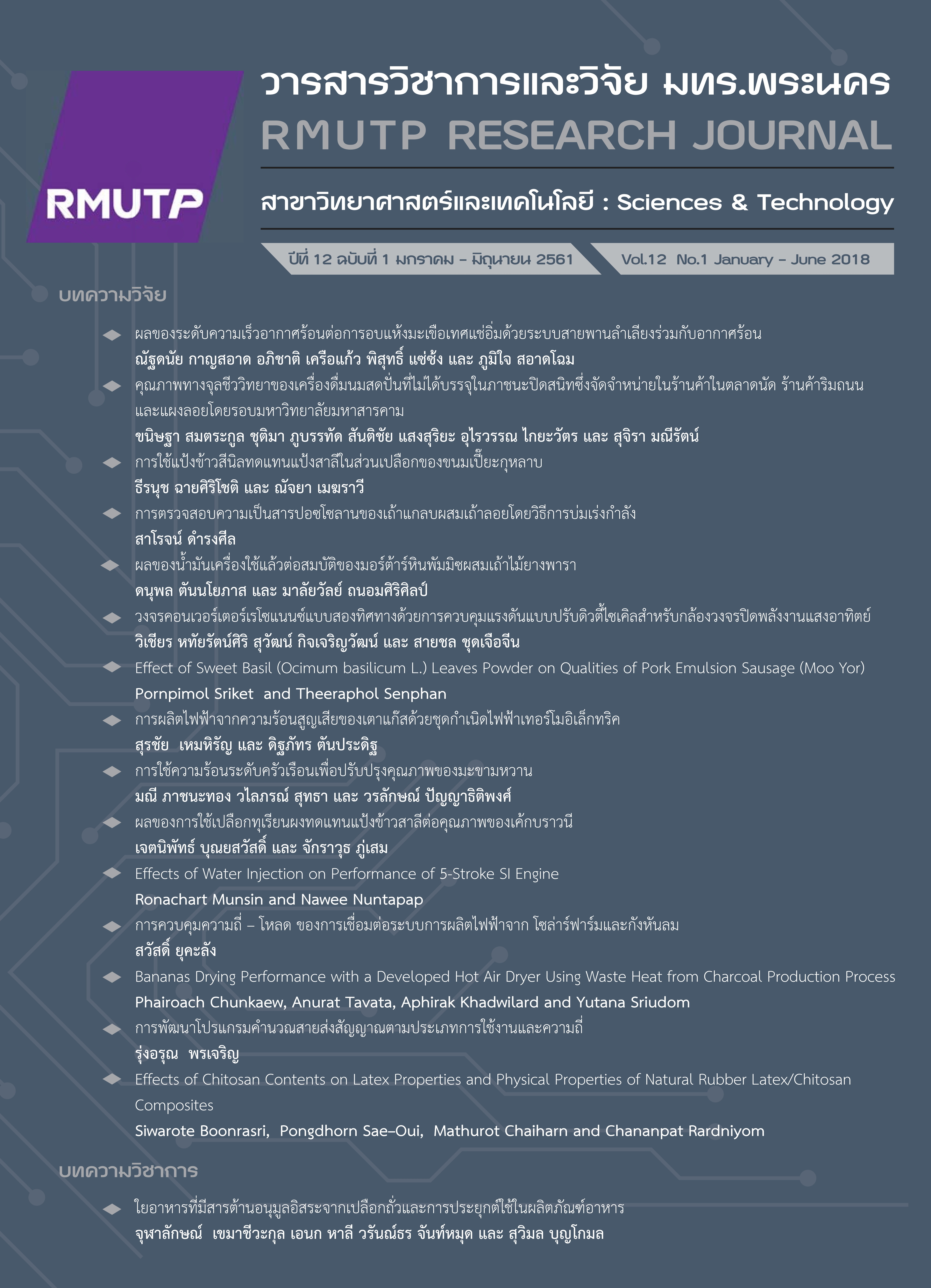การใช้ความร้อนระดับครัวเรือนเพื่อปรับปรุงคุณภาพของมะขามหวาน
Main Article Content
บทคัดย่อ
มะขามหวานเป็นพืชเอกลักษณ์และพืชเศรษฐกิจของจังหวัดเพชรบูรณ์ และได้รับการขึ้นทะเบียนบ่งชี้ทางภูมิศาสตร์ ปัญหาสำคัญของมะขามหวานคือ การเสื่อมเสียจากเชื้อราซึ่งไม่สามารถมองเห็นได้จากภายนอก ทำให้ผู้บริโภคไม่มั่นใจในคุณภาพ โดยเฉพาะมะขามหวานจากกลุ่มชุมชนขนาดเล็ก จึงทำการศึกษาการใช้ความร้อนระดับครัวเรือนเพื่อปรับปรุงคุณภาพโดยใช้ไอน้ำร้อนที่อุณหภูมิ 100 องศาเซลเซียส เป็นเวลา 50, 60, 70 และ 80 นาที นำไปทำแห้งด้วยตู้อบลมร้อนที่อุณหภูมิ 70 องศาเซลเซียส เป็นเวลา 3 ชั่วโมง พบว่าการให้ความร้อนแก่มะขามหวานเพิ่มมากขึ้นมีผลทำให้สีของมะขามหวานคล้ำขึ้นและมีผลทำให้เนื้อของมะขามหวานมีปริมาณความชื้นสูงขึ้นอย่างมีนัยสำคัญทางสถิติ (p<0.05) และจากการศึกษาการทำแห้งมะขามหวานด้วยตู้อบลมร้อนที่อุณหภูมิ 60, 70 และ 80 องศาเซลเซียส พบว่าการใช้อุณหภูมิในการทำแห้งที่สูงขึ้นมีผลทำให้ระยะเวลาในการทำแห้งลดลงและมะขามหวานมีสีคล้ำขึ้น นอกจากนี้การเพิ่มอุณหภูมิในการทำแห้งมีผลทำให้ความชื้นและคะแนนความชอบทางประสาทสัมผัสของมะขามหวานลดลงอย่างมีนัยสำคัญทางสถิติ (p<0.05) การเก็บมะขามหวานในถุงตาข่ายที่อุณหภูมิห้อง พบว่าเวลาการเก็บรักษาที่เพิ่มขึ้นมีผลทำให้ความชื้นของเปลือกมะขามหวานเพิ่มขึ้นอย่างมีนัยสำคัญทางสถิติ (p<0.05) และสามารถรักษาสภาพที่ดีของมะขามหวานได้อย่างน้อย 12 สัปดาห์ โดยไม่พบการเสื่อมเสียของมะขามหวานจากเชื้อรา
Article Details

This work is licensed under a Creative Commons Attribution-NonCommercial-NoDerivatives 4.0 International License.
ลิขสิทธ์ ของมหาวิทยาลัยเทคโนโลยีราชมงคลพระนครReferences
B. Jarimopas, D. Rachanukroa, S.P. Singh, R. Sothornvit, “Post-harvest damage and performance comparison of sweet tamarind packaging,” Journal of Food Engineering, vol. 88 pp. 193-201, 2008.
Department of Agriculture, Postharvest Diseases of fruit, 1st ed. Bangkok: Chamchuri Product, 2014.
C. Sartpetch, A. Suwanagul, M. Lanchai, T. Boonlkang and J. Pankhwan, “Effect of Sulfur dioxide on postharvest qualities of sweet tamarind cv. Si thong,” in Proceeding of 53rd Kasetsart University Annual Conference, Thailand, 2015, pp. 454-458.
C. Oupadissakoon, E. Chambers IV, V. Kongpensook, S. Suwonsichon, R. Yenket and A. Retiveau, “Sensory properties and consumer acceptance of sweet tamarind varieties grown in Thailand,” Journal of The Science of Food and Agriculture, vol. 90, pp. 1081-1088, 2010.
L. Ruck and C.T. Brown, “Quantitative analysis of Munsell color data from archeological ceramics,” Journal of Archaeological Science: Reports, vol. 3, pp. 549-557, 2015.
N. Van den Bilcke, K. Alaerts, S. Ghaffaripour, D.J. Simbo and R. Samson, “Physico-chemical properties of tamarind (Tamarindus indica L.) fruits from Mali: selection of elite trees for domestication,” Genetic Resources and Crop Evolution, vol 61, pp. 537-553, 2014.
M. Riederer, K. Arand, M. Burghardt, H. Huang, M. Riedel, A. Schuster, A. Smirnova and Y. Jiang, “Water loss from litchi (Litchi chinensis) and longan (Dimocarpus longan) fruits is biphasic and controlled by a complex pericarpal transpiration barrier,” Planta, vol. 242, pp. 1207-1219, 2015.
S. Suktanarak and S. Teerachaichayut, “Detection for moisture content of sweet tamarind flesh by transmittance short wavelength near infrared spectroscopy,” in International Proceeding of Chemical, Biological and Environment, International Conference on Nutrition and Food Sciences, Singapore, 2012 pp. 71-75.
S. Luengthanaphol, D. Mongkholkhajornsilp, S. Douglas, P.L. Douglas, L. Pengsopa and S. Pongamphai, “Extraction of antioxidants from sweet Thai tamarind seed coatpreliminary experiments,” Journal of Food Engineering, vol 63, pp. 247-252, 2004.
M. Miranda, A. Vega-Galvez, P. Garcia, K.D. Scala, J. Shi, S. Xue and E. Uribe, “Effect of temperature on structural properties of Aloe vera (Aloe barbadensis Miller) gel and Weibull distribution for modelling drying process,” Food and Bioproducts Processing, vol. 88, pp. 138-144, 2010.
I. Karabulut, A. Topcu, A. Duran, S. Turan and B. Ozturk, “Effect of hot air drying and sun drying on color values and β-carotene content of apricot (Prunus armenica L.),” LWT-Food Science and Technology, vol. 40 pp. 753-758, 2007.
H. Sabarez, W.E. Price, P.J. Back and L.A. Woolf, “Modelling the kinetics of drying of d’ Agen plums (Pruns demestica),” Food Chemistry, vol. 66, no. 3, pp. 371-382, 1997.
A. Wojdylo, A. Figiel and J. Oszmianski, “Effect of drying methods with the application of vacuum microwaves on the bioactive compounds color, and antioxidant activity of strawberry fruits,” Journal of Agricultural and Food Chemistry, vol. 57, pp. 1337-1343, 2009.
F.A. Mohos, Confectionery and Chocolate Engineering: Principles and Applications, 1st ed. Singapore: Wiley-Blackwell, 2010.
J.M. deMan, Principles of Food Chemistry, 3rd ed. Maryland: Aspen, 1999.
J. Ryckeboer, J. Mergaert, K. Vaes, S. Klammer, D.D. Clercq, J. Coosemans, H. Insam and J. Swings, “A survey of bacteria and fungi occurring during composting and self-heating processes,” Annals of Microbiology, vol. 53, no. 4, pp. 349-410, 2003.
D. Udayanga, X. Liu, E.H.C. McKenzie, E. Chukeatirote, A.H.A. Bahkali and K.D. Hyde, “The genus Phomopsis: biology, applications, species concepts and names of common phytopathogens,” Fungal Diversity, vol 50, pp.189-225, 2011.
L.M. Coated, A.W. Cooke and J.R. Dean, “The response of mango stem end rot pathogens to heat”, in Proceeding of V International Mango Symposium (ISHS), Acta Horticulturae, 1997, pp. 762-772.

